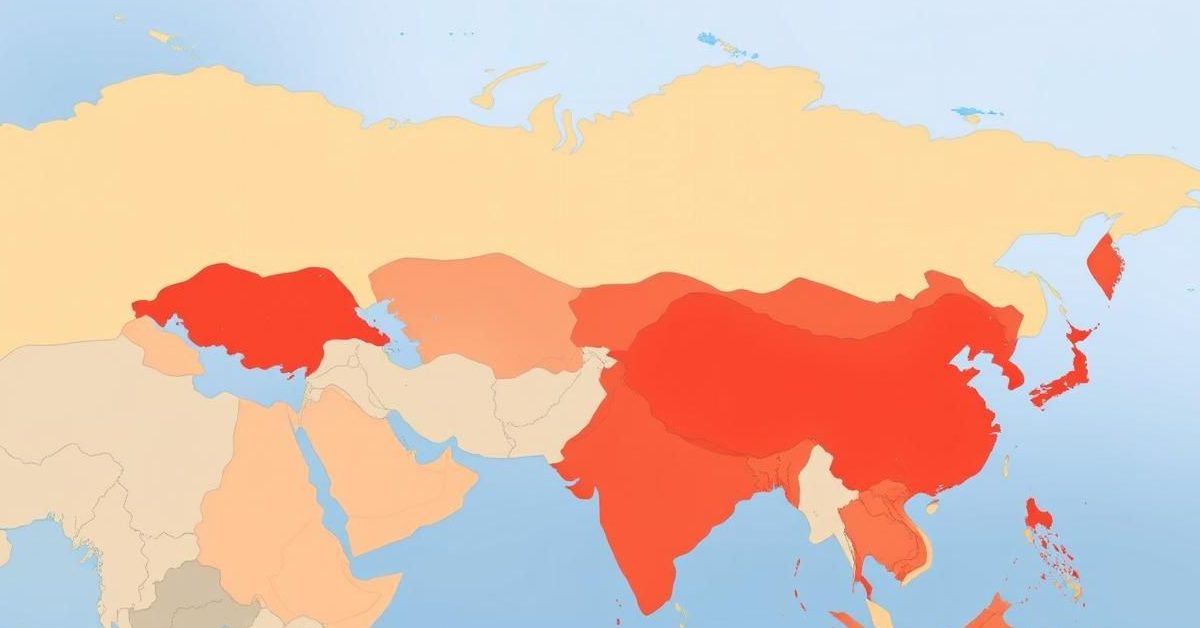Understanding the Shanghai Cooperation Organisation (SCO): A Geopolitical Powerhouse
The **Shanghai Cooperation Organisation (SCO)** stands as a formidable player in the global arena, often misunderstood despite its immense geographical reach and demographic footprint. It represents a significant regional bloc, primarily focusing on security, economic cooperation, and cultural exchange across Eurasia.
The group holds the distinction of being the world’s largest regional organization, spanning vast territories and encompassing nearly half of the global population. Far from being a European-centric entity, the SCO is predominantly composed of Asian nations, shaping the security architecture of a vital part of the world.
From “Shanghai Five” to Global Influence
The roots of the SCO stretch back to 1996, born from the “Shanghai Five” mechanism. This initial group comprised **China, Russia, Kazakhstan, Kyrgyzstan, and Tajikistan**. Its formation was a direct response to the volatile aftermath of the Soviet Union’s dissolution in 1991, aiming to coordinate efforts against rising radicalism and ethnic tensions in Central Asia. India, notably, was not part of this foundational “Shanghai Five.”
The SCO officially evolved into its current form on June 15, 2001, in Shanghai. Over the years, its membership has expanded significantly, now including **India, China, Russia, Pakistan, Kazakhstan, Kyrgyzstan, Tajikistan, Uzbekistan, Iran, and Belarus**. This expansion underscores its growing influence and the increasing number of nations seeking to collaborate on regional security and development.
Security Focus and Counter-Terrorism Efforts
A cornerstone of the SCO’s mandate is addressing security concerns, particularly **terrorism, separatism, and extremism**. The organization established the **Regional Anti-Terrorist Structure (RATS)**, which facilitates regular intelligence sharing and coordination among member states. This dedicated mechanism highlights the bloc’s commitment to maintaining regional stability.
However, internal dynamics and differing national interests occasionally surface, as evidenced when **India’s Defence Minister Rajnath Singh** declined to endorse a draft statement at an SCO conference. His stance stemmed from the statement’s omission of a specific reference to a terror assault in Pahalgam, India, while including an incident in Pakistan. Such instances reveal the complex political nuances at play within this powerful multinational body.
The Caroline Test: A Landmark in International Law of Self-Defense
At the very heart of international law concerning the use of force lies the **Caroline test**, a crucial principle that defines the limits of a state’s right to self-defense. This customary rule dictates that a nation can only legitimately employ force when faced with an “imminent, overwhelming threat” that leaves “no moment for deliberation” and “no means of escape.” It’s a high bar, designed to prevent pre-emptive strikes based on speculative dangers.
A Dramatic Incident Forged a Legal Standard
The origins of this seminal test trace back to a dramatic event in **1837**, on the Niagara River between the United States and Canada. During the Upper Canada Rebellion, American sympathizers were providing aid to Canadian rebels via the steamship *Caroline*. In a bold move, **British forces crossed into US territory** and destroyed the *Caroline* to prevent further attacks on Canada.
The subsequent diplomatic exchanges between the US Secretary of State, **Daniel Webster**, and the British Ambassador, **Lord Ashburton**, over this incident, solidified the core tenets of the Caroline test. Their correspondence laid down the stringent criteria for anticipatory self-defense, emphasizing the necessity and proportionality of any such military action.
Modern Relevance: Debating Pre-Emptive Strikes
Even nearly two centuries later, the Caroline test remains highly relevant, serving as a legal benchmark in contemporary conflicts. Its principles are frequently invoked in debates surrounding the legality of pre-emptive military actions, such as those undertaken by **Israel** against alleged threats in the region.
Legal scholars and international bodies often scrutinize whether a nation’s use of force genuinely meets the “imminent, overwhelming threat” standard. For instance, some experts argue that any military action not in response to an immediate, clear danger, like a nuclear attack that doesn’t even exist, would violate this long-standing rule of international law. The Caroline test thus continues to shape global discourse on sovereignty, aggression, and legitimate defense.
Iran’s Nuclear Core: Natanz, Isfahan, and Fordow
The names **Natanz, Isfahan, and Fordow** resonate globally, signifying critical sites within **Iran’s** controversial nuclear program. These facilities are not merely industrial complexes; they represent the nexus of Iran’s nuclear ambitions and the subject of intense international scrutiny, particularly from Western powers and the **International Atomic Energy Agency (IAEA)**.
Targets of Espionage and Alleged Attacks
These Iranian nuclear sites have unfortunately become flashpoints in geopolitical tensions, with reports of sophisticated sabotage and alleged attacks. The United States and Israel, among others, have been accused of targeting these facilities to impede Iran’s nuclear progress. Such actions are unprecedented, marking one of the first times operational nuclear facilities have reportedly been targeted for destruction by external forces.
The international community, including the IAEA, monitors these sites closely, but these incidents raise profound concerns. The potential for a **radiation leak** is a constant worry, with catastrophic environmental and human consequences. Beyond the immediate physical damage, such incidents exacerbate regional instability and complicate efforts towards non-proliferation.
Safeguarding Nuclear Materials and Regional Stability
Despite the alarming nature of these attacks, both Iran and the IAEA have, thus far, reported no increases in ambient radiation levels. However, fundamental concerns persist regarding the safety and secure location of the highly sensitive nuclear materials stored within Natanz, Isfahan, and Fordow. The implications of these incidents extend far beyond Iran’s borders, affecting global security and the delicate balance of power in the Middle East.
Geographical Flashpoints in the Russia-Ukraine Conflict
The protracted conflict between **Russia and Ukraine** continues to reshape the geopolitical landscape, with its grim consequences felt across cities and towns that now bear the scars of war. Recent intense aerial bombardments illustrate the widespread devastation, impacting civilian lives and critical infrastructure far beyond the front lines.
Attacks Across the Ukrainian Landscape
In a recent harrowing aerial assault, Russia unleashed an unprecedented barrage of drones and missiles across Ukraine. Cities like **Drohobych**, nestled in western Ukraine and considerably distant from the main combat zones, experienced direct hits, with a drone strike igniting an industrial fire and causing widespread power outages. This demonstrates the far-reaching and indiscriminate nature of the offensive.
Meanwhile, the human cost of the conflict remains devastatingly high. In **Cherkasy**, located in central Ukraine, at least six individuals, including a child, sustained injuries in the relentless attacks. Such incidents underscore the constant danger faced by civilians in areas under bombardment.
Cross-Border Impact and Military Dynamics
The conflict’s reach extends into Russian territory as well, with Ukraine employing drones in retaliatory strikes. The **Bryansk region in western Russia** reported the interception of several Ukrainian drones, with two individuals sustaining injuries from a separate strike. These cross-border attacks highlight the escalating nature of the conflict and the tit-for-tat exchanges.
Amidst these intense operations, Ukraine also confirmed the loss of an F-16 warplane, reportedly supplied by Western allies. The aircraft crashed after being damaged while engaging enemy targets, tragically claiming the pilot’s life. Such losses emphasize the high stakes and the continuous attrition of military assets in this brutal and protracted war.
Joint Base San Antonio: A New Front in US Border Security
The **Joint Base San Antonio (JBSA)**, a significant United States military installation, finds itself at the forefront of evolving national security strategies, particularly concerning the nation’s southern border with **Mexico**. In a controversial move, the Department of Defense has expanded a militarized zone along this border, empowering troops to detain individuals entering illegally for potential federal prosecution.
Militarizing the Southern Frontier
This policy shift gained momentum following the declaration of a national emergency at the border, particularly under the **Trump administration**. The Air Force, for instance, announced the annexation of a sprawling 250-mile (400-kilometer) stretch of the border in **Texas**, effectively extending the reach of JBSA. The Navy has also been directed to establish a new national defense area, signaling a more robust military presence along the frontier.
The newly designated national defense area encompasses both land and water segments along the **Rio Grande**, incorporating major Texas towns like **Brownsville and McAllen**. Warning signs are being erected to prohibit unauthorized entry, transforming these areas into extensions of military jurisdiction.
From New Mexico to Texas: A Growing militarized Zone
This military strategy was first implemented in **April** along a 170-mile (275-kilometer) section of the **New Mexico border** before being expanded into western Texas. While aimed at deterring illegal immigration and enhancing border security, these measures have sparked considerable concern. Civil liberties advocates, humanitarian aid organizations, and even local hunters and hikers fear that these expanded zones will restrict public access and infringe upon fundamental rights in communities along the border.















